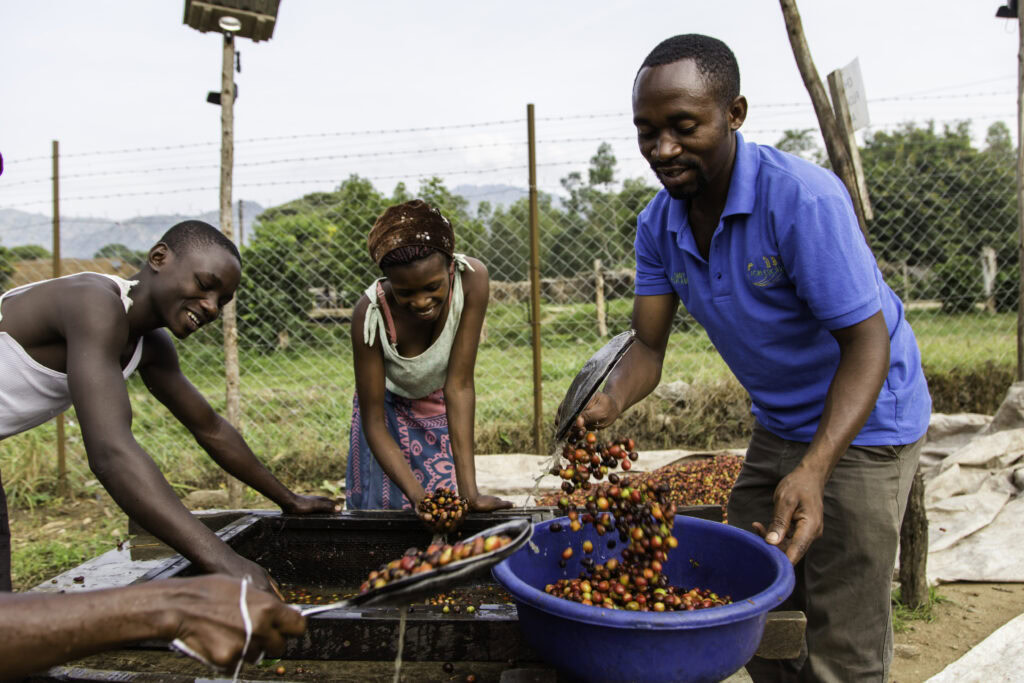A coffee cherry is made up of several layers which include skin, fruit, mucilage and parchment. After the cherries are picked, they require processing which involves removing these layers. This can be done in a number of ways and each process can impart a different cup profile on the coffee.
Washed Process Coffee
The washed coffee procedure entails removing each layer of the coffee cherry before drying. While natural or honey processed coffees use the outside fruit to provide flavour, washed coffees rely nearly entirely on the inside bean having absorbed enough carbs and flavour during its maturation. This means that environmental factors such as climate and terroir, as well as operational factors like fermentation and drying, are critical in revealing the coffee’s genuine flavour.
Natural Process Coffee
Ripe cherries are collected and sorted for ripeness before being transported to a drying area in their entirety. It is then placed on a surface, such as a patio, table, elevated bed, or mechanical drier – or a mix of these – and let to dry. The next step requires cautious management. Natural processing is difficult because of the potential of uneven or overfermentation, which occurs when the fruit is left to dry for an extended period of time, as well as the formation of moulds. At best, these moulds reduce coffee flavours; at worst, they induce defective flavours or pose a microbiological risk to ingestion. The coffee is turned frequently to avoid this, ensuring the maximum surface area is exposed to the air to facilitate an even drying. After an agreed amount of time when the coffee reaches a set moisture level, all of the outer layers of the dried cherry are removed in one step by a de-pulper or hulling machine.
This method tends to create a very bright, vibrant and intense cup, often with high sweetness and a heavy body.
Honey Process Coffee
This is a process that sits in between washed and natural. These coffees are often fruit-forward, with a with medium sweetness and body and always a balanced level of consistency and clarity; showcasing both washed and natural processing cup attributes.
After the harvested coffee is pushed through a de-pulper, rather than being placed in fermentation tanks like washed processing, the coffee is transferred immediately to the drying section, leaving the sticky mucilage intact. Producers frequently experiment with leaving varying amounts on the coffee to obtain distinct cup characteristics and colours, each affecting the time of the fermentation process. This applies to white, yellow, gold, black, or red honey coffees that may appear on a coffee label.
Anaerobic / Anoxiccoffee processing
The phrase “anaerobic” is a broad descriptor in the coffee business, referring to a fermentation environment with limited oxygen. “Anoxic” is a phrase that is becoming increasingly often used, as it relates to the condition of the environment in which the fermentation occurs, capturing the substance of the process’s difference more precisely. Coffees prepared in this way follow processes identical to those of a natural or washed coffee, with the exception that the fermentation tanks are sealed vessels, equipped with a one-way air valve that admits air out but not in. The low oxygen levels limit the types of microbes that survive and engage in fermentation, giving the producers more control in the process, and a more constant end-result. Anaerobically processed coffee generally has a funky and complex flavour profile.
Carbonic Maceration Coffee Processing
In a carbonic method for coffee processing, coffee cherries are added to an airtight fermentation tank with a one-way valve, similarly to the anaerobic method. However, in carbonic maceration, the cherries are left intact, and the tank is injected with carbon dioxide. This process was originally used for wine production as an innovative way to ferment grapes without breaking their skins. The resulting carbon-dioxide rich environment causes a unique, internal fermentation reaction within the coffee cherry, opening new opportunities for producers to create new and complex flavour profiles, usually rich in dark red fruit notes.
Thermal Shock Processing
Thermal shock Coffee processing is a modern experimental method in which coffee is subjected to severe temperature variations during processing. Producers can be creative because there are countless options for experimenting with the thermal shock process, which produces limitless results. The idea of exposing or alternating coffee to hot or cold environments is to ‘lock in’ and optimise taste and fragrance ingredients. The resulting coffee typically has a bright and sweet character.

